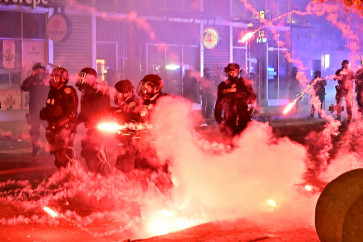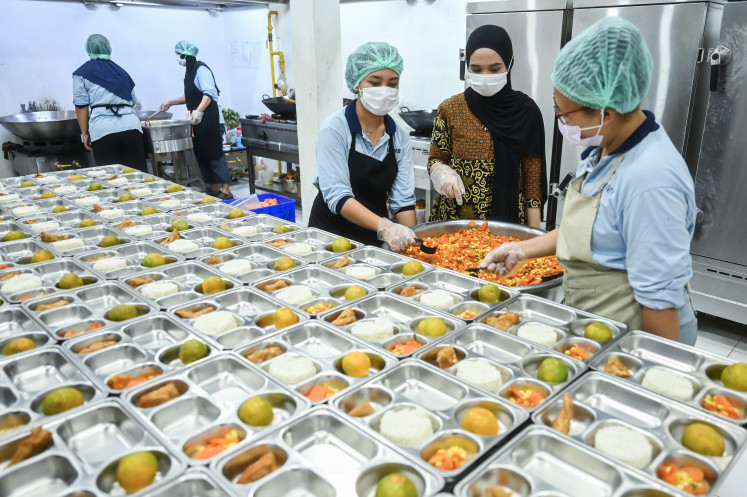Popular Reads
Top Results
Can't find what you're looking for?
View all search resultsPopular Reads
Top Results
Can't find what you're looking for?
View all search resultsGovt sets ambitious target of reducing forest fires by half
The government has unveiled a grand strategy to reduce annual land and forest fires in the country over the next three years, aiming to halve the number of hot spots by 2019
Change text size
Gift Premium Articles
to Anyone

T
he government has unveiled a grand strategy to reduce annual land and forest fires in the country over the next three years, aiming to halve the number of hot spots by 2019.
The grand strategy is an ambitious nationwide effort that will involve no fewer than 16 ministries and government agencies, encompassing 731 fire-prone villages in 66 cities and regencies in eight provinces: Riau, Jambi, South Sumatra, Central Kalimantan, South Kalimantan, West Kalimantan, East Kalimantan and Papua.
National Development Planning Board (Bappenas) head Bambang Brodjonegoro said the master plan, called the Land, Plantation and Forest Fire Prevention Grand Design, would be coordinated by the Office of the Coordinating Economic Minister, with the assistance of Bappenas and the Environment and Forestry Ministry.
“So that land and forest fires do not happen again in the future, the grand design focuses more on preventative measures, as instructed by President [Joko ‘‘Jokowi’’ Widodo],” Bambang said.
There are five strategies in the master plan. First is providing economic incentives and disincentives.
Herry Purnomo, a scientist at the Center for International Forestry Research (CIFOR) and professor at Bogor Agricultural University, who helped design the master plan, said the reward and punishment mechanism would be implemented in 731 villages.
“We are allocating Rp 300 million [US$22,388] per village for three years to make sure that there’s no more fires,” he said.
The government could also provide incentives for villages that managed to keep their localities fire-free by improving the livelihoods of the residents, such as by providing tractors, added Herry.
The second strategy is to strengthen the roles of villagers, while third is law enforcement and synchronization of regulations and permits in the land management sector.
The fourth strategy is infrastructure development in fire-prone regions, while the last is strengthening early-fire response planning. In total, the three-year strategy is set to cost Rp 39 trillion, half of which will go to the Peatland Restoration Agency (BRG), who is tasked with restoring up to 2.4 million hectares of damaged peatland, as well as block canals to prevent fires from happening.
“Funding for the BRG is a lot because re-wetting [dried out peatland] costs $1,000 per ha,” Herry said.
While the cost of preventing forest fires was high, BRG head Nazir Foead said the cost of putting out fires was even higher. “The amount of money needed to prevent [forest fires] is equivalent to 20 percent of putting out fires,” he said.
The aim of the grand design is to significantly reduce annual land and forest fires and to increase the coordination among ministries and government agencies.
Last year’s fire season was one of the worst on record, as more than 2 million ha of fragile forest land was destroyed, costing $15 billion in damages.
Thanks to La Niña weather patterns, this year has seen a drop in the number of hot spots, down 75 percent compared to that in 2015.
However, fires are expected to return in full force next year, with the dry season to make a return.
“We are grateful that this year we are having a wetter dry season,” Nazir said. “But the challenge will be the dry season returning to normal next year. We have about seven to eight months to prepare and make accurate and detailed plans.”
According to the grand strategy, the government expects 49.35 percent reduction of hot spots in 2017, down from 25,171 to 12,750.
To help the government achieve that target, BRG deputy head for planning and cooperation Budi Wardhana said the peatland agency was currently preparing detailed zonal mapping of fire-prone peatland areas in seven provinces that had been suffering from the annual fires.
“The grand strategy will refer to our map, which is currently under development,” he said. “Why is the map important? Because it is part of grand design for readiness.”
The map will also be used by Bappenas in developing regional development planning.
“When a regional development plan is submitted to Bappenas, the board will cross-check the plan with the map,” Budi said.









